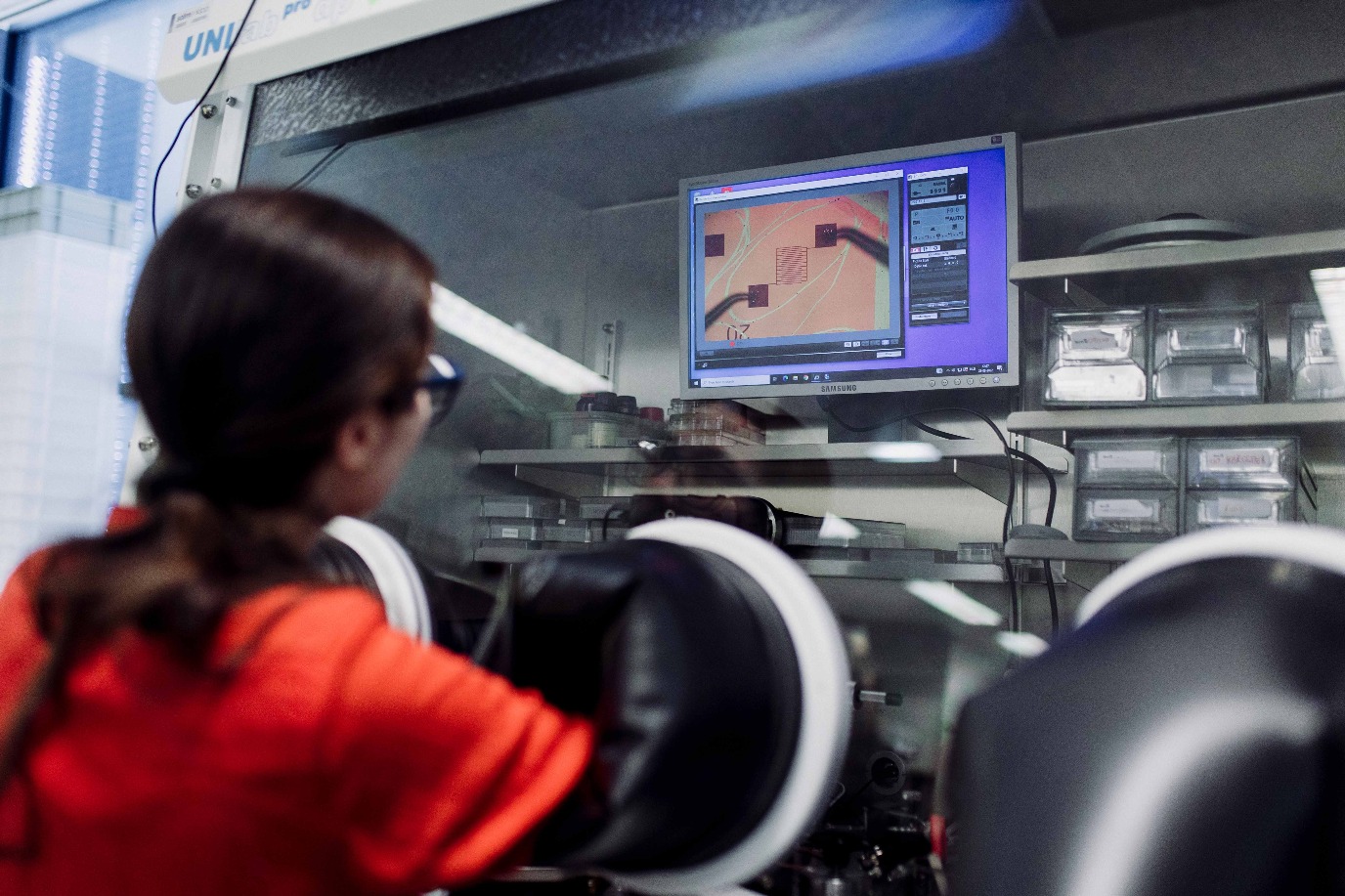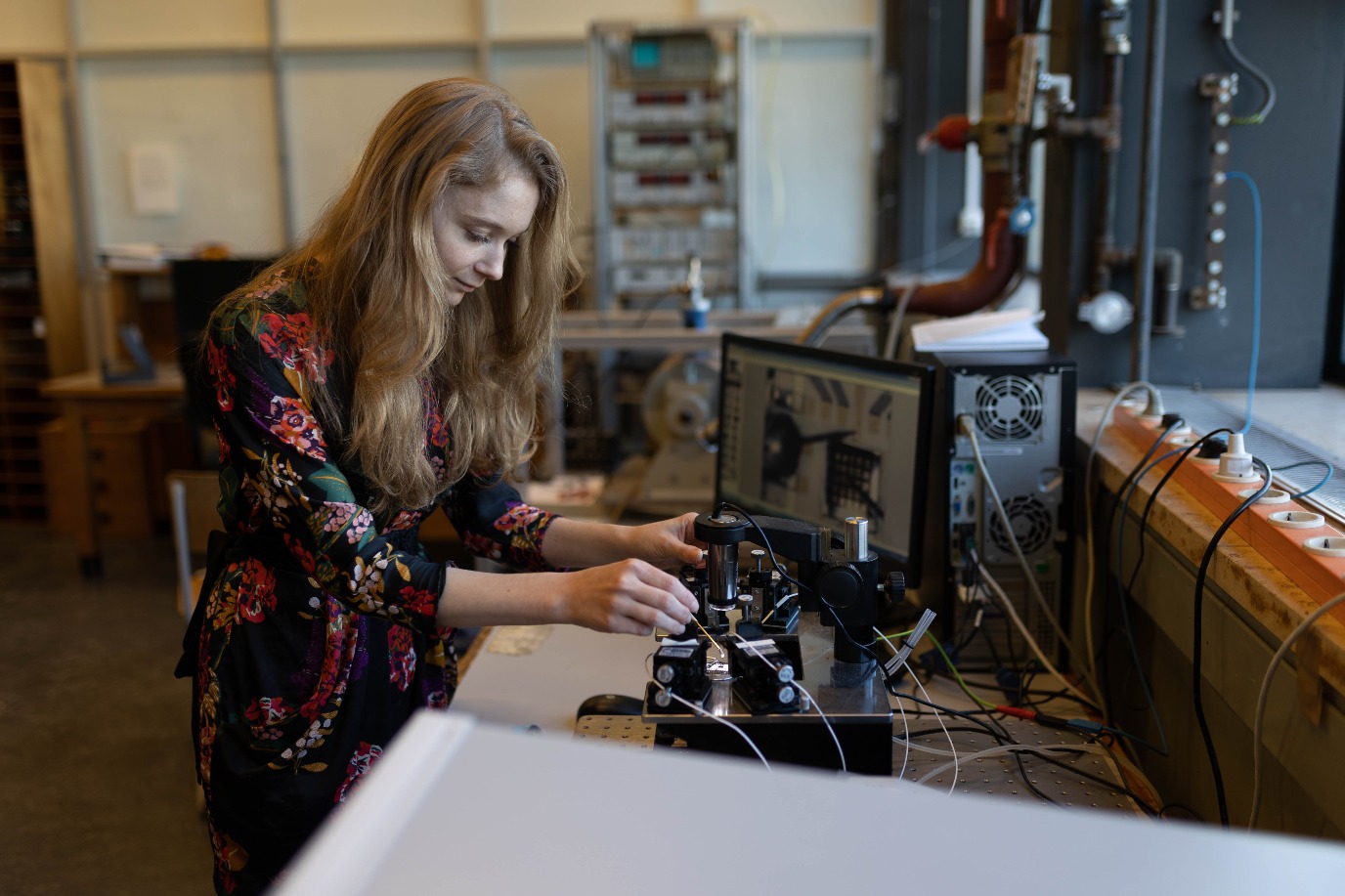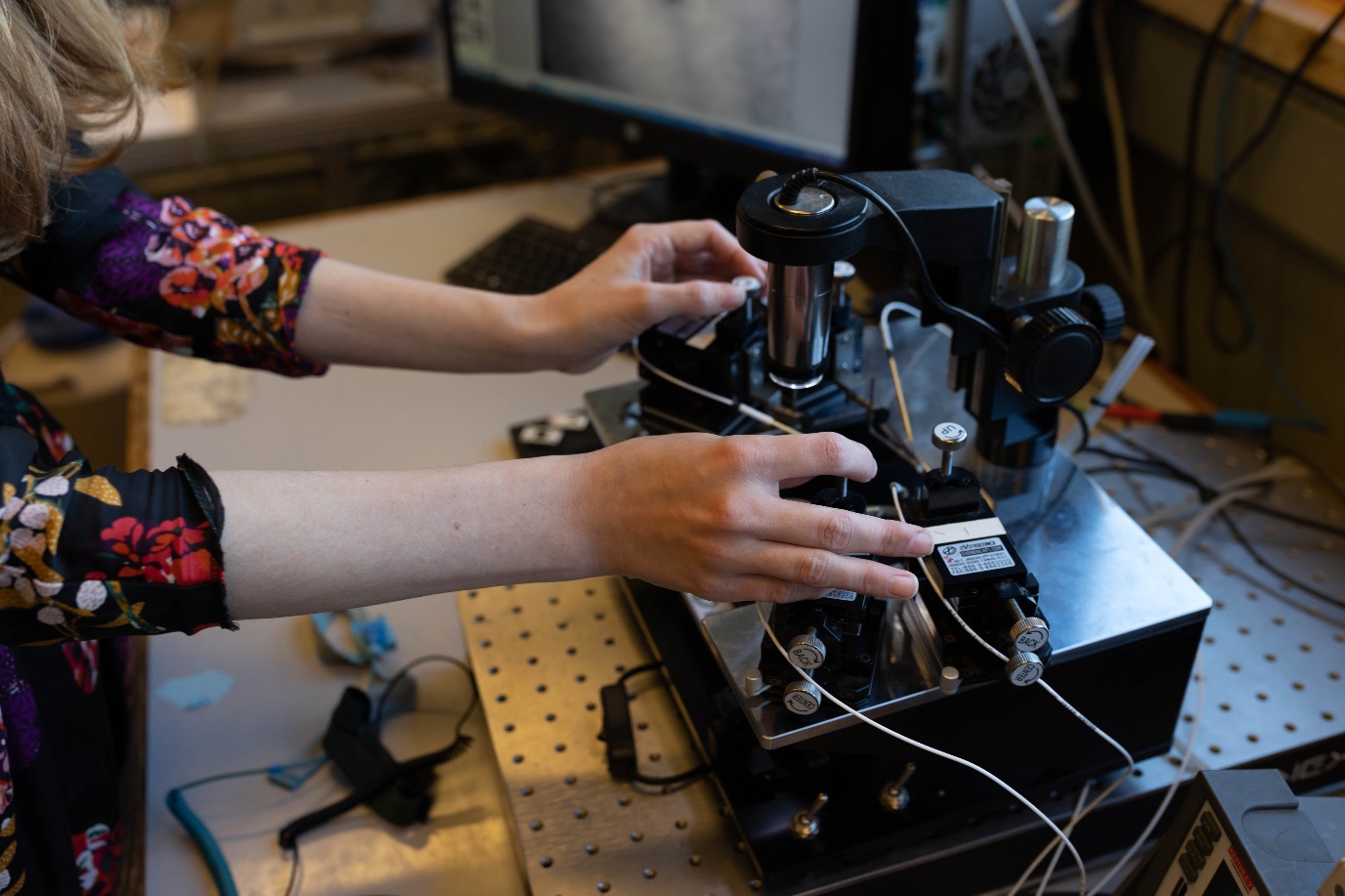De chips van de toekomst

‘De computers die we nu hebben zijn niet gemaakt voor AI,’ vertelt Beatriz Noheda, hoogleraar en directeur van het Groningen Cognitive Systems and Materials Center (CogniGron). Daardoor gebruiken ze onnodig veel energie, en bovendien lopen we tegen de limieten van onze huidige technologie aan. Dus werkt CogniGron aan nieuwe materialen die het menselijk brein kunnen nabootsen. Ook ontwikkelt CogniGron-hoogleraar Tamalika Banerjee met de start-up IMChipN binnenkort chips voor energiezuinige computers.
FSE Science Newsroom | Charlotte Vlek

‘Stel je voor dat je een ruimte vol mensen binnenloopt, op zoek naar één specifiek persoon,’ vertelt Noheda. Voor een mens is die taak een peulenschil, maar een computer, zelfs moderne AI-gebaseerde gezichtsherkenning, is hier helemaal niet zo goed in. De computer zal één voor één alle pixels bestuderen, en dat kost vreselijk veel energie. Terwijl wij mensen snel kunnen prioriteren (alleen naar gezichten kijken) en meerdere dingen tegelijk kunnen checken (zwart haar of blond, bril of geen bril). Noheda: ‘Om een gezicht te herkennen heeft een computer zo’n 20.000 Watt nodig, terwijl een mens daar naar schatting slechts 20 Watt voor nodig heeft.’
Om een gezicht te herkennen heeft een computer zo’n 20.000 Watt nodig, terwijl een mens daar naar schatting slechts 20 Watt voor nodig heeft.
En dat terwijl veel van de moderne AI is geïnspireerd op het menselijk brein – zoals de populaire Machine Learning-techniek, waarbij een computer afbeeldingen leert herkennen door met een heleboel trainingsmateriaal te ‘oefenen’. Het probleem is dat we die AI-algoritmes uitvoeren op digitale computers die helemaal niet op het brein lijken. Juist dat maakt AI zo’n grote energie slurper.
Over hardware en software
Een menselijk brein werkt structureel anders dan een computer: het slaat informatie niet alleen op als nullen en enen, maar ook als alles daartussenin. En nieuwe informatie wordt als het ware in de hardware zelf opgeslagen: in de verbindingen tussen neuronen. Een kind dat bijvoorbeeld de connectie tussen de klank ‘papa’ en het gezicht van papa leert, ontwikkelt ook fysiek sterke verbindingen tussen neuronen in de hersenen.
Om één neuron na te bootsen, zijn een heleboel transistors nodig
Noheda: ‘Het brein kent geen verschil tussen hardware en software, of tussen geheugen en verwerking. Alles is geïntegreerd.’ Daarnaast kunnen de verbindingen in het brein dus zwak of sterk zijn, of iets daar tussenin – heel anders dan de transistors op een computerchip die alleen ‘aan’ of ‘uit’ staan en daarbij informatie in nullen en enen opslaan.
Noheda legt uit wat een verschil dat maakt: ‘Om één neuron na te bootsen, zijn een heleboel transistors nodig. Wij werken met nieuwe systemen, zogenaamde memristors: hardware die met het gebruik geleidelijk evolueren, afhankelijk van hoeveel stroom er in het verleden doorheen gegaan is.’ Net als een kind dat sterkere verbanden in het brein aanlegt, dus. In het bijzonder werkt Noheda zelf met kristallen waarin een netwerk van lijnen stroom kan geleiden. Naarmate er meer stroom doorheen is gegaan geleiden die lijnen beter. ‘Dat is dus hoe wij leren!’ vertelt Noheda. ‘En dit kristal kunnen we op nanoschaal laten groeien in ons lab.’
Natuurwetten aanwenden
Het netwerk van lijnen in de kristallen van Noheda ontstaan doordat moleculen in zo’n kristal niet allemaal in dezelfde positie staan. Daardoor ontstaan domeinen van gelijkgerichte moleculen, en de scheidslijnen tussen die domeinen blijken meer te geleiden dan de rest. Bovendien kennen ze daarin gradaties: ze kunnen dus meer toestanden aannemen dan alleen nul (niet geleidend) of één (wel geleidend). De randen geleiden ook nog eens méér als er al eerder een stroompje doorheen is geweest: het gedraagt zich als memristor.
Promovendus Jan Rieck onderzoekt deze kristallen in het lab, terwijl promovenda Anne-Men Huijzer onder begeleiding van wiskundige Bart Besselink bekijkt hoe die memristors zich in een netwerk gedragen. Zouden ze bijvoorbeeld neurale netwerken, zoals die veel in de AI gebruikt worden, kunnen nabootsen – en wel direct in het materiaal? Noheda: ‘Het lijkt erop dat bepaalde eigenschappen van neurale netwerken als vanzelf goed gemodelleerd worden in een netwerk van memristors. Zo kun je dus als het ware de natuurwetten aanwenden waarmee je bepaalde berekeningen cadeau krijgt.’




Over geheugen en verwerking
Denk aan medische toepassingen, zelfrijdende auto’s, maar ook bijvoorbeeld de gaming industrie: die vereisen instantane beslissingen, zonder enige vertraging op de lijn
‘Als je je laptop openschroeft,’ vertelt Banerjee, ‘dan zul je kunnen zien dat de processor en het geheugen van je laptop op twee verschillende locaties zitten.’ Daarnaast sturen we ook nog eens heel veel data naar de cloud, terwijl het toch één tot twee seconden kost om die data weer op te halen. En hier is nog een weetje: één datacentrum (de cloud steunt op vele van zulke datacentra) gebruikt ongeveer zoveel stroom als 80.000 huishoudens.
Geheugen en verwerking dicht bij elkaar houden zal dus energiezuiniger zijn. ‘Bovendien beperkt de snelheid van die data-uitwisseling ook de snelheid van de computer in z’n geheel,’ aldus Banerjee. ‘Denk aan medische toepassingen, zelfrijdende auto’s, maar ook bijvoorbeeld de gaming industrie: die vereisen instantane beslissingen, zonder enige vertraging op de lijn.’
IMChipN , Banerjee’s start-up in de maak, zal in-memory chips maken met een combinatie van oude en nieuwe materialen, waarbij geheugen en verwerking op dezelfde plek plaatsvinden. De N in de naam staat voor North: omdat Banerjee het bedrijf graag hier in de regio houdt. Haar promovendi hebben in het lab al gewerkt aan de ontwikkeling van de benodigde nieuwe materialen en apparaten: ‘We hebben hier het NanoLab en onze eigen CogniGron-labs, waarin we al veelbelovend werk hebben verzet.’
Nieuwe materialen en apparaten ontwikkelen
Banerjee heeft zelf jarenlang met silicium-chips gewerkt. ‘Maar de huidige materialen zijn beperkend voor de mogelijkheden van apparaten,’ vertelt Banerjee.
In Banerjee’s lab werken PhD-studenten met complexe oxide. ‘Deze materialen hebben veel meer mogelijkheden dan silicium,’ vertelt Banerjee. ‘Je kunt ze zo bewerken dat ze een halfgeleider worden, of een supergeleider. Je kunt ze ferroelektrisch maken, of hun magnetische ordening veranderen.’ Het zijn allemaal fysieke eigenschappen die het gedrag van het materiaal bepalen, en door die slim in te zetten kun je een memristisch apparaat maken.
Banerjee legt uit: ‘We kunnen het materiaal zo bewerken dat het zich gaat gedragen als een netwerk van neuronen en de verbindingen daartussen, en dat het, zoals die neuronen, waarden tussen nul en één aan kan aannemen. We hebben laten zien dat het ook op nanoschaal heel goed werkt. Sterker nog, juist op een kleine schaal hebben we spectaculaire resultaten geboekt.’
IMChipN
Volgens Banerjee worden huidige computers beperkt door drie problemen: (1) geheugen en verwerking zitten niet op dezelfde plaats (2) het kan wel één tot twee seconden duren om data heen en weer te sturen naar de cloud en (3) na jaren van innovaties komen we nu aan het einde van wat met de huidige materialen mogelijk is.
Daarom wil ze met IMChipN nieuwe hardware aanbieden, die makkelijk te fabriceren is, duurzaam, en die kan combineren met bestaande technieken. Het bedrijf zal een chiplet ontwikkelen, een kleine chip-op-maat voor een specifieke taak.
Lees ook:
Een robotarm in een fabriek die herhaaldelijk dezelfde beweging maakt: dat is iets van het verleden, vindt Ming Cao. Wetenschappers van de Rijksuniversiteit Groningen werken samen met hightech bedrijven om productieprocessen steeds meer autonoom te maken.
Meer nieuws
-
06 januari 2026
AI-phasie: kunstmatige intelligentie helpt bij taalgebrek
-
06 januari 2026
Beter zicht op de werkpaarden van ons lichaam
